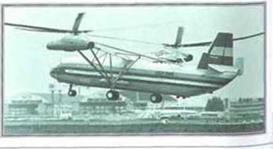V-12
• Twin rotor • Heavylift helicopter • Unbroken records

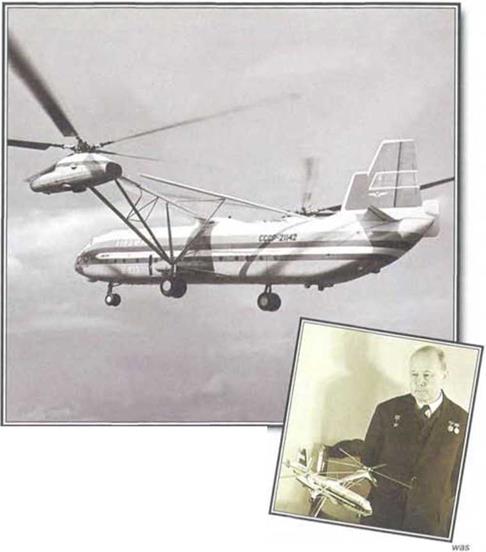 Everything about the V-12 was enormous. The twin-rotor giant shattered every record for helicopter payload, and mado every previous rotarywing machine seem like a toy. But the problems of operating such a machine were also enormous and, despito the Ingenuity of the design, it was not roally a viablo machine for commercial use. After a momorable appearance at the Paris Air Show, the V-12 rarely flew again.
Everything about the V-12 was enormous. The twin-rotor giant shattered every record for helicopter payload, and mado every previous rotarywing machine seem like a toy. But the problems of operating such a machine were also enormous and, despito the Ingenuity of the design, it was not roally a viablo machine for commercial use. After a momorable appearance at the Paris Air Show, the V-12 rarely flew again.
 |

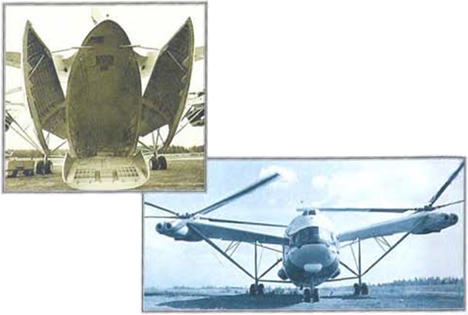
 |
A Loading ramp
Practical touches like tho rear clamshell doors and loading ramp showed that the V – 12 was not just a record breaker. Tho fuselage intenor also had four cargo winches and a reinforced floor structure.

 ▼ Paris performance
▼ Paris performance
The Pans Air Show was the V – 12’s greatest moment, attracting enormous attention. But there was little interest in tho machine from foreign customers.
|
|
FACTS AND FIGURES
► Tho enormous D-2S turboshaft engines were also used In other very large Mil hollcoptors like the Ml-6 and Mi-10.
► Tho one remaining V-12 con be soon at the Monino air force museum In Moscow.
► Tho V-12 had hydraulic flight controls, but It could also be flown manually.
► Fully loaded, tho V-12 was os hoavy as nlno Mi-24 •Hind’ gunships, or more than twico as hoavy os an MI-6.
>• Tho main cabin of tho V-12 was 28.1 S n’ (83 ft.) long ond 4.4 m (47 ft.) square.
> Optional forry tanks could be carried inside the V-12 for maximum range.

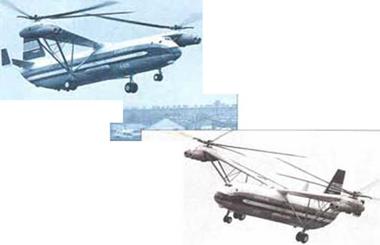

![]()
![]()
![]()
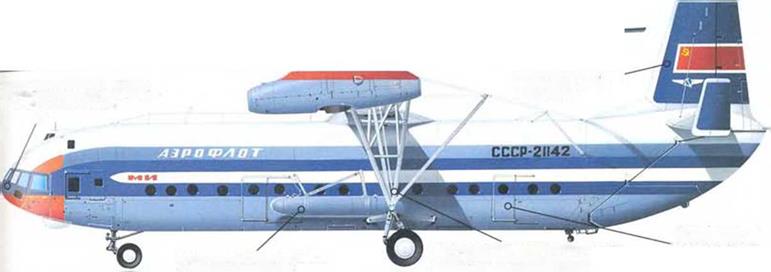
Produced by the man who had built the world s previous largest helicopter. Mikhail Leontyevich Mil the 12 was a giant W ith л mavitmtin lake-oil weight nt over 100 tonnes, it Was biggei than manv transport. lircrati Dcvelo|Hxl with the engines. tnulMmvsion and rotors of the Mi-ti. but in double |K)d> outlv. uil of a long reverse-taper wing, the -li lud a huge fuselage space that contained one-tonne cargo hoists ami seats could ІЧ’ lined for more-
than too passengers The V-I2 even had a split-level flight deck, with pilots and flight engineer lxdow and navigator and radio operator alxive The lust V-12 was damaged in a crash in І‘ХГ. mused by resoiunce and control system problems. Ihe second appeared at the I’ans ir Show and went on to break nutty helico|Mor payload атоїхк. most of which (vmain to this day But despite its stunning performance and size, the V-12 was not really economical to use*, and Mil
Above: Twin-rotor power was a new concept for the Mil company. Despite overcoming many of the technical difficulties, the V-12 was plagued by problems with resonance.
decided to develop the Mi-26 lor heavy cargo Work instead, leaving tlx – V-12 in a museum,
Below: The Soviet obsession with having the biggest and fastest of everything was manifest in the V-12. Mil turned his attentions to the more successful Mi-26 after the problems with the V-12 became apparent.
 |
|
|
|
|
|
|
|
|
|
|
 |
|||
Ueng tour engmea trот the Ш4. the V-12 had nrnxra power The modern M. 20 has ahnosl the same poem trom two more modem enpnet. winch dnvo through a leas waste IU ttarvsnxtaen The СН-5ЭС la dr hen by three rntolrvaly small angne*
 The V-12 had а тпжигмп UAe-oft woght tX 105 torrw*. or mom than a MadM VUcim Bens** The CM-53 s dnirlod try №• much lug»
The V-12 had а тпжигмп UAe-oft woght tX 105 torrw*. or mom than a MadM VUcim Bens** The CM-53 s dnirlod try №• much lug»

![]()


![]()
 >.U httec&Ti, Out a an почти таеЫ-е. the M.-2S л emost as heavy as a My loaded С-1 Э0 Horses* at та»rm»n oi-up weghc.
>.U httec&Ti, Out a an почти таеЫ-е. the M.-2S л emost as heavy as a My loaded С-1 Э0 Horses* at та»rm»n oi-up weghc.
M. 26 HALO
«•53f 56000 kg (123,453 0) )
13400 kg (73.414 lb.)
Mil











